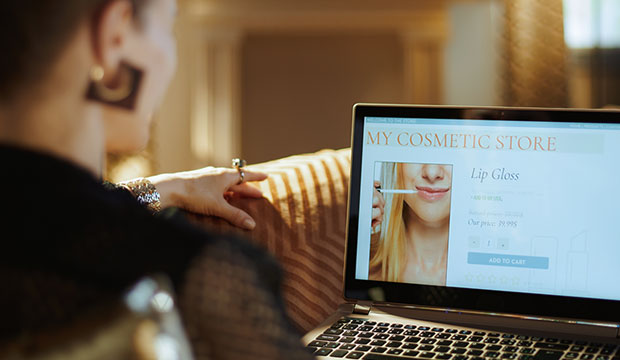Cosmetics companies traditionally have relied on in-person retail sales to attract new customers and maintain existing clientele. The pandemic, however, has upended the cosmetics industry, bringing new challenges as well as a host of opportunities for companies that are agile and creative enough to take advantage.
The E-Commerce Times spoke with experts in cosmetic sales and e-commerce about trends in this dynamic and evolving industry.
Personalization Trends
One way that cosmetics companies can appeal to online customers is to provide increasingly personalized services.
“What sets us apart is we’ve created an expert online beauty assessment that’s been developed by a team of data scientists, makeup artists and skin care specialists,” Jaleh Bisharat, co-founder and CEO of the cosmetics company NakedPoppy, told the E-Commerce Times.
“Think of it as your online beauty consultant. Once you’ve taken your three-minute assessment, we use patent-pending technology to rate every product in our store just for you. This creates your personalized clean beauty boutique, featuring your perfect picks.”
That kind of personalization can help bridge the gap between customers and an online store, approximating and perhaps surpassing the experience they might get at a physical makeup counter.
“We believe the future is in personalization,” explained Bisharat. “I see a world in which some day everyone will shop their unique, personalized beauty boutique and not have to waste time on the products that are not for them.”
Cosmetics companies can gather data about new customers and maintain information about existing ones to provide a unique online shopping experience tailored to each customer’s needs.
“Marketers could display a survey for first-time visitors to learn more about their preferences, like a store associate would,” Ben Malki, director of customer success for Dynamic Yield, explained to the E-Commerce Times.
“Then, using the information captured, such as whether they are interested in clean or vegan products or have sensitive skin, to serve up a more customized experience. Product recommendations can act as another helpful extension of the in-store staff.”
This kind of personalization can also help to link customers’ in-store experiences with their online shopping.
“For those who previously engaged with brands exclusively offline but are now starting to do so digitally, marketers from the beauty industry can combine offline transactions with their online activity,” said Malki.
“This can be done by building a segment consisting of those who recently made a purchase offline and serving them with relevant content upon arriving to the site or opening an email, converting them into online shoppers more efficiently.”
Ultimately, personalization can maintain and grow a customer base and also prevent revenue lost from returned and unusable products.
“Personalization can also help minimize product returns,” noted Malki. “As purchased beauty products cannot be re-shelved and sold, by implementing a greater degree of personalization, customers can be matched with items that best suit their distinct needs. This not only increases the likelihood of product satisfaction, but also reduces the costs associated with returns.”
Pricing and Packaging Beauty
The cosmetics industry is also being transformed by new trends in pricing and packaging. Smart pricing strategies, for instance, are helping companies to maintain an edge in a competitive e-commerce marketplace.
“Cosmetics companies are part of the lucky minority in the global e-commerce landscape, in the sense that they have really high margins,” explained Burc Tanir, CEO of Prisync, a company that provides competitor price tracking and a dynamic pricing engine for e-commerce businesses.
“This is actually a great opportunity in a growing market with a growing customer base, where pricing can be a secret marketing weapon. E-commerce companies in this space can adjust their prices competitively without sacrificing their solid profit margins at all. In other words, they can maintain a competitively-priced yet profitable position in their market to grow their top-line and bottom-line at the same time.”
Similarly, as consumers are becoming more eco-conscious, cosmetics companies are changing how their products are packaged and sold.
“The use of recycled plastics is a first step for environmentally-friendly cosmetics packaging,” Robert Lockyer, CEO of Delta Global, a luxury packaging company, told the E-Commerce Times.
“Alongside this, recyclable packaging is also needed, as well as efforts to educate customers how items should be disposed of sustainably — for instance, with clear labelling on bottles and tubes.”
Reusable packaging has become another way that cosmetics companies can appeal to environmentally-minded consumers.
“Companies can promote a circular economy by creating packaging that can be reused,” said Lockyer. “For example, perfume bottles or makeup tubes can be cleaned and displayed as decorative ornaments. However, this requires investment into high-quality and visually-appealing packaging, whereby the exterior becomes just as much a part of the product as the internal formula.”
A New Complexion
The new world of cosmetics e-commerce is just that — a global endeavor, no longer limited to customers within a specific country.
“COVID-19 has accelerated the need for retailers to strengthen their online presence and accessibility to global shoppers,” Matthew Merrilees, CEO North America of Global-e, explained to the E-Commerce Times.
“While domestic e-commerce sales have increased, they’re not necessarily enough to replace the current loss of brick-and-mortar, so retailers must increasingly take advantage of the enormous untapped potential of selling to international customers to expand their revenue.”
The changes the pandemic has brought to the cosmetics industry will likely remain even after COVID-19 is over, and those companies that can adapt to the new realities of online cosmetics sales will be those that can survive and thrive in the future.
“The desire for no-touch shopping won’t disappear any time soon,” said NakedPoppy’s Bisharat. “I think consumers are now sensitized to how viruses or bacteria of any kind can spread, and I predict that as a result, people will avoid or minimize the use of testers.
“Some will also maintain a residual preference to not have another person get near their face. What this means is any solution that helps her find and buy perfect-for-her cosmetics in no-touch fashion will have an advantage.”
























































Social Media
See all Social Media